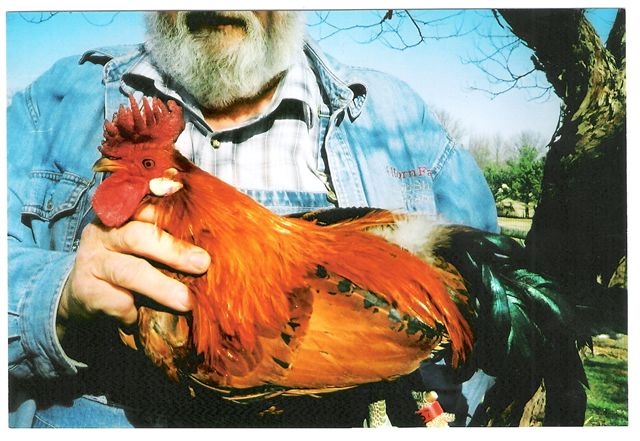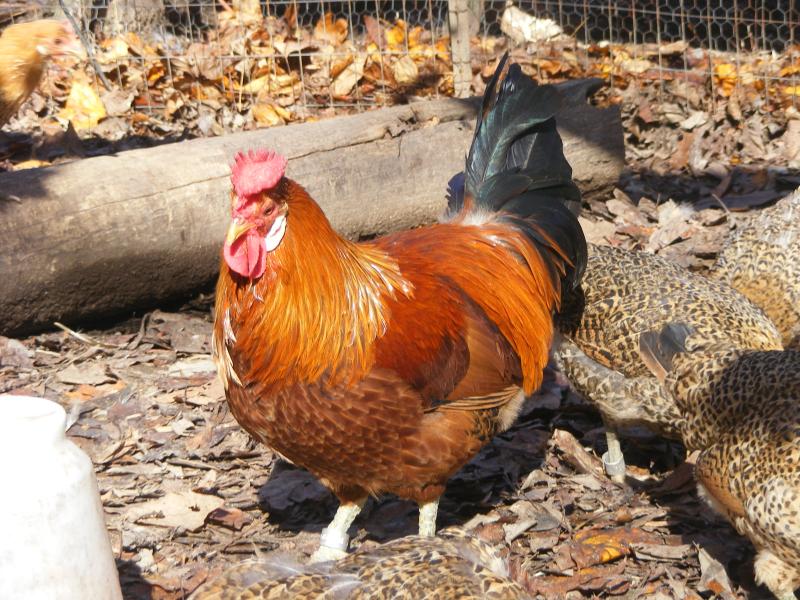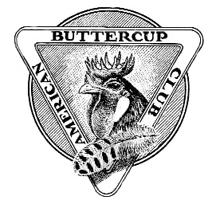Getting Started with Buttercups
By Carl Fosbrink, 2011
A long-time poultry breeder and judge, Carl was instrumental in bringing back the Buttercup from near extinction.
Buttercups are starting to make a comeback in the poultry world, but there are only a few specimens available that are good representatives of the breed.
You may be attracted to the Buttercup breed because you like their appearance or because you like a breed that lays a good number of eggs or maybe you want to preserve an endangered breed of poultry. Whatever your reason you may wonder how to go about obtaining some birds for breeding or what to look for when purchasing stock to get you started in the Buttercup breed.
I found myself in this same position a few years ago. I realized that I had only seen a few Buttercups at the poultry shows in the last 30 years and that the ones I had seen weren't very good representatives of the breed. I decided that I wanted to obtain some Buttercups in order to keep them from disappearing. I was worried that a specimen with an actual closed comb might be impossible to find.
I began my search. I asked all my poultry friends to keep an eye out for anyone that might have Buttercups because I didn't find any advertised for sale. I eventually was told there was a person in New York by the name of Burkemeier that had some. I contacted him and he was very friendly. He told me he had them for several years and had not introduced any new blood because he couldn't find any that were of good enough quality that he wanted to introduce them to his breeding program. We agreed that the best way for me to obtain some of his stock was to get some hatching eggs that he would send to a show in Ohio and I could drive there from Indiana and pick them up.
I picked the eggs up and put them in the incubator as soon as I returned home. A good number of the eggs hatched and I watched them with great anticipation as the chicks matured enough to see what their color and combs were going to be like. Of the 25 chicks that hatched I was elated that a couple of them actually had CLOSED COMBS. The color was too dark in their hackles and saddles and there was a lot of ticking, but there was actually a couple with closed combs. This excited me to no end as I was afraid that trait might have been lost forever, but here it was and I knew at that point that the Buttercup breed could be saved.
I was still looking for more Buttercups because I knew these birds were closely related. I was told there was a woman in California that had some Buttercups so I tried to locate her only to find she had passed away about a month before. No one seemed to know where her birds had gone. I saw in Poultry Press that Larry Stallings from California was reviving the old Buttercup Club so I contacted him and asked him about this woman's birds. Larry didn't know what had happened to her birds, but said he would try to find out what had happened to them because he would like to have some of them too. It took him about six months, but he located the birds and they had been sold to someone for egg layers. Larry was able to purchase some of the birds so I sent Larry some money and a shipping box to send me a cockerel by Express Mail.
When the cockerel arrived he was in good condition. I was excited. I opened the box and the cockerel did not have a closed comb, but his hackle and saddle were the good BUTTER COLOR that was lacking in the birds I already had.
I mated this cockerel to the females with closed combs that I already had. This is called a COMPENSATION MATING when you mate birds together that have opposite good qualities. Good butter colored hackles and saddles to good closed combs. I ended up with a few birds that had the good qualities of both parents, good color and good combs. All of the birds had good leg color and most of them had good white ear lobes. It is important to tell you that when you are working with birds that need a lot of improvement that you should only expect to keep about the top 10% for breeding and showing. The other 90% can be sold for meat or egg layers to someone interested in that aspect of poultry.
To improve a breed you need to RAISE as MANY as you can raise with proper care and CULL HEAVILY. Use males with good color as type comes more from the female and color from the male. That is why I used the good colored male on the good typed, and combed females. Do not get in a hurry to cull birds as they go through several molts while growing and it is hard to tell their true color until they get their adult feathers at about 6 to 7 months of age. Things that can be culled for before maturity are physical defects like crooked toes, crossed beaks, a crooked breast bone or roach back etc. Good eye color is more important than the points it receives in the Standard of Perfection. Green colored eyes often mean poor health, but never cull for eye color until 6 months of age.
It costs as much to feed a bad bird as it does to feed a good bird so buy the best quality birds you can find to begin with. You could spend a lot of money for feed and a lot of years to breed up to what you could purchase in the beginning for a little more money. Try to obtain your birds from a breeder and not from a hatchery. It is not necessary to buy perfect birds, but it is necessary that the birds you buy carry the genes for a closed comb and a butter colored hackle and saddle. Remember compensation mating and to keep from getting your birds inbred use your best cockerels on your old hens and your best cock bird on your pullets.
The Buttercup gets it's name from it's cup-shaped comb and the butter-colored hackle and saddle. These are the two most important things that your birds need to possess. Always keep them in mind when you purchase birds and when you set up your matings and enjoy the WONDERFUL BUTTERCUP!
-- Carl Fosbrink, Jan. 2011
You may be attracted to the Buttercup breed because you like their appearance or because you like a breed that lays a good number of eggs or maybe you want to preserve an endangered breed of poultry. Whatever your reason you may wonder how to go about obtaining some birds for breeding or what to look for when purchasing stock to get you started in the Buttercup breed.
I found myself in this same position a few years ago. I realized that I had only seen a few Buttercups at the poultry shows in the last 30 years and that the ones I had seen weren't very good representatives of the breed. I decided that I wanted to obtain some Buttercups in order to keep them from disappearing. I was worried that a specimen with an actual closed comb might be impossible to find.
I began my search. I asked all my poultry friends to keep an eye out for anyone that might have Buttercups because I didn't find any advertised for sale. I eventually was told there was a person in New York by the name of Burkemeier that had some. I contacted him and he was very friendly. He told me he had them for several years and had not introduced any new blood because he couldn't find any that were of good enough quality that he wanted to introduce them to his breeding program. We agreed that the best way for me to obtain some of his stock was to get some hatching eggs that he would send to a show in Ohio and I could drive there from Indiana and pick them up.
I picked the eggs up and put them in the incubator as soon as I returned home. A good number of the eggs hatched and I watched them with great anticipation as the chicks matured enough to see what their color and combs were going to be like. Of the 25 chicks that hatched I was elated that a couple of them actually had CLOSED COMBS. The color was too dark in their hackles and saddles and there was a lot of ticking, but there was actually a couple with closed combs. This excited me to no end as I was afraid that trait might have been lost forever, but here it was and I knew at that point that the Buttercup breed could be saved.
I was still looking for more Buttercups because I knew these birds were closely related. I was told there was a woman in California that had some Buttercups so I tried to locate her only to find she had passed away about a month before. No one seemed to know where her birds had gone. I saw in Poultry Press that Larry Stallings from California was reviving the old Buttercup Club so I contacted him and asked him about this woman's birds. Larry didn't know what had happened to her birds, but said he would try to find out what had happened to them because he would like to have some of them too. It took him about six months, but he located the birds and they had been sold to someone for egg layers. Larry was able to purchase some of the birds so I sent Larry some money and a shipping box to send me a cockerel by Express Mail.
When the cockerel arrived he was in good condition. I was excited. I opened the box and the cockerel did not have a closed comb, but his hackle and saddle were the good BUTTER COLOR that was lacking in the birds I already had.
I mated this cockerel to the females with closed combs that I already had. This is called a COMPENSATION MATING when you mate birds together that have opposite good qualities. Good butter colored hackles and saddles to good closed combs. I ended up with a few birds that had the good qualities of both parents, good color and good combs. All of the birds had good leg color and most of them had good white ear lobes. It is important to tell you that when you are working with birds that need a lot of improvement that you should only expect to keep about the top 10% for breeding and showing. The other 90% can be sold for meat or egg layers to someone interested in that aspect of poultry.
To improve a breed you need to RAISE as MANY as you can raise with proper care and CULL HEAVILY. Use males with good color as type comes more from the female and color from the male. That is why I used the good colored male on the good typed, and combed females. Do not get in a hurry to cull birds as they go through several molts while growing and it is hard to tell their true color until they get their adult feathers at about 6 to 7 months of age. Things that can be culled for before maturity are physical defects like crooked toes, crossed beaks, a crooked breast bone or roach back etc. Good eye color is more important than the points it receives in the Standard of Perfection. Green colored eyes often mean poor health, but never cull for eye color until 6 months of age.
It costs as much to feed a bad bird as it does to feed a good bird so buy the best quality birds you can find to begin with. You could spend a lot of money for feed and a lot of years to breed up to what you could purchase in the beginning for a little more money. Try to obtain your birds from a breeder and not from a hatchery. It is not necessary to buy perfect birds, but it is necessary that the birds you buy carry the genes for a closed comb and a butter colored hackle and saddle. Remember compensation mating and to keep from getting your birds inbred use your best cockerels on your old hens and your best cock bird on your pullets.
The Buttercup gets it's name from it's cup-shaped comb and the butter-colored hackle and saddle. These are the two most important things that your birds need to possess. Always keep them in mind when you purchase birds and when you set up your matings and enjoy the WONDERFUL BUTTERCUP!
-- Carl Fosbrink, Jan. 2011
American Buttercup Club
Join UsWould you like to become a member of the American Buttercup Club? Click here to join us!
About the ClubClick here to learn more about our club's mission and what we do!
ArticlesClick here to read great articles about the breed.
|
About the BreedWant more information and history about this incredible breed? Click here to learn more!
BlogClick here to read our blog and stay up to date on our latest news!
LinksClick here to find useful links to other websites with Buttercup breeders and more information.
|
|


